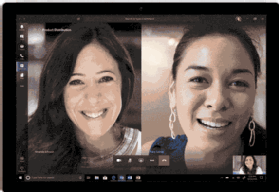Microsoft to support cloud meetings with on-prem Skype for Business
Microsoft bows to customer demand to keep on-premises Skype for Business for calling and messaging, while using Teams only for cloud meetings.
ORLANDO, Fla. -- Microsoft will let Skype for Business customers use the Teams collaboration service exclusively for online meetings -- a move likely to please enterprises that want to keep their on-premises calling and messaging.
Microsoft unveiled a preview of the new setup this week at Enterprise Connect. The company designed the product for large businesses that want to protect six-digit investments in calling hardware, while taking advantage of the scalability and advanced features of so-called cloud meetings in Teams.
Microsoft released an updated on-premises server for Skype for Business last year that will extend support for the product through at least 2023. At the same time, Microsoft has largely stopped innovating on the Skype platform, as it nudges users toward Teams.
The latest on-premises server gave businesses the ability to migrate users directly from Skype to Teams, rather than having to migrate them first to cloud-based Skype for Business Online.
Some enterprises have complained that Teams does not yet support calling features advanced enough to meet their needs. Other large organizations have privacy and regulatory concerns about storing messaging data in the cloud.
The cloud-meetings-only mode will provide a steppingstone for businesses by letting them disable the calling and messaging features of Teams.
Microsoft said 500,000 organizations had begun piloting or using Teams over the last two years. However, the vendor has consistently declined to say how many daily active users exist within those organizations.

Microsoft Teams to support private channels
Microsoft plans to introduce private channels within Teams later this year that will be visible only to the members of those channels. Microsoft would not specify when that feature -- long sought by users -- would launch.

Private channels let a subset of users within a team work on sensitive or confidential projects, keeping the chats and files within that channel invisible to other members of the team. Microsoft will also soon release information barriers, a feature that will let businesses restrict communications among internal users.
Cisco Webex Teams does not support private communications. Channels within a group are visible to all members. Microsoft, on the other hand, lets Teams users set up multiple secret channels within a group.
Nevertheless, Microsoft hasn't caught up to Slack, which has supported private channels within workspaces -- roughly equivalent to a team in the Microsoft and Cisco products -- since October 2015. In January 2018, Slack took private channels one step further by enabling private shared channels for collaboration among separate companies.
Microsoft innovates with digital whiteboard features
Microsoft also highlighted at Enterprise Connect the public preview of a digital whiteboard feature in Teams for commercial customers.
The feature lets participants in cloud meetings collaborate on a virtual canvas meant to simulate a physical whiteboard. Microsoft showcased two aspects of its whiteboard feature that could differentiate Teams from competing products.
Teams will be able to convert a picture of a physical whiteboard into a digital canvas, so the information can be stored in Teams and edited in an online meeting. What's more, in Microsoft Teams Rooms, businesses will be able to use any USB camera to stream the image of a physical whiteboard into Teams.
Microsoft's technology will automatically frame and enhance the physical whiteboard and will make transparent anyone that walks in front of the camera, so remote participants can continue to see the board.








